A.V.Vikulin, PhD med., V.A.Markin, PhD med., Moscow State Medical and Dental University;
A.V.Grinev, PhD med. Sechenov First Moscow State Medical University
«Новое в стоматологии» («The New in Dentistry») Journal, No 8, 2013
In spite of success, achieved in the prevention and cure of teeth caries and aftereffects, dentists in their practice often have to deal with considerably demolished teeth (10). Full destruction of the upper part of the tooth as the result of caries, injury, pathological erasability, non-carious damage, followed by root removal may be the cause of functional and structural disruption of jaw-dental system (1,2).
The process of reconstruction of considerably demolished teeth includes 3 main stages:
- endodontic treatment;
- tooth core buildup;
- reconstruction of the tooth anatomic form.
Recent years have seen wide dissemination of direct teeth reconstruction methods with the use of pins and composite materials, applied in the mouth of the patient (3, 8, 9).
A big variety of composite materials can be used for the tooth core reconstruction. Composite materials are widely used for this purpose (4) because of esthetic appearance (6), possibility to accomplish tooth core buildup and tooth preparation for artificial crown during one seance, and also due to reliable adhesion indicator (11-28 МПа) (7) when composite is used together with primer-bonding system for dentin.
JSC «StomaDent» has worked out a new composite flowable dual-cure material for the fixation of pins and tooth core buildup.
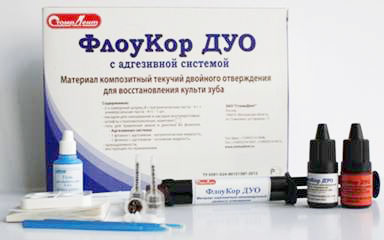
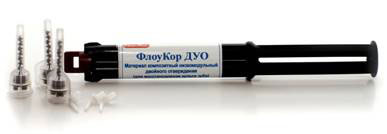 Picture 1. Composite flowable dual-cure material «FlowCor Duo»
Picture 1. Composite flowable dual-cure material «FlowCor Duo»
Purpose of the study
To demonstrate the possibilities of tooth core buildup with the use of fiberglass pins and composite flowable dual-cure material.
Materials and methods
Fiberglass pins have been used for our study. The root channel has been worked up to 1/2 of its length with the use of pilot reamers. Then with the use of calibrating reamers the root channel was prepared for the required pin size. The root channel was etched with gel containing 35% ortophosphoric acid in the course of 20 seconds. Then gel was washed away, and the channel was dried with air and paper absorbers. On the prepared tooth surface dual-cure adhesive was placed in 1:1 proportion, rubbed in, blown with air and cured with light for 20 seconds. Composite flowable dual-cure material was mixed on the mixing pad in 1:1 proportion with the use of disposable plastic spatulas during 30 seconds until homogenous state has been achieved. Then the material was put in the root channel with the use of channel filler and the pins were fixed. The material was cured with light for 20 seconds. After polymerization the excess of the material was removed.
The remaining tooth tissues were etched, the adhesive was placed, light-cured. The composite material was prepared following the above described procedure. The tooth core was modeled with the used of cap-former. The material was light-cured for 20 seconds.
In 5-7 minutes after polymerization the created tooth core was prepared for the chosen construction. After preparation all teeth core were covered with temporary crowns.
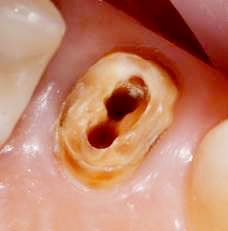
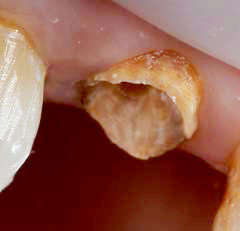 Picture 2. Root channels widened for fiberglass pins installation
Picture 2. Root channels widened for fiberglass pins installation
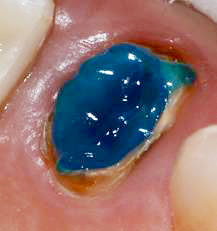 Picture 3. Root channel etched with gel containing 35% orthophosphoric acid
Picture 3. Root channel etched with gel containing 35% orthophosphoric acid
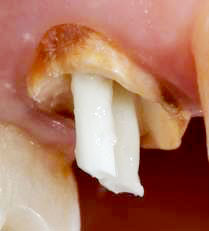
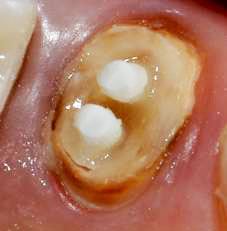 Picture 4. Fiberglass pins cut to required length and fixed in the root channel
Picture 4. Fiberglass pins cut to required length and fixed in the root channel
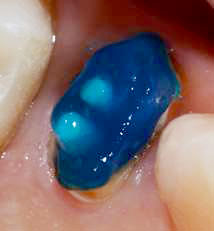
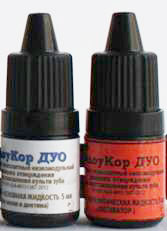 Picture 5. Tooth tissues etched with gel containing 35% orthophosphoric acid. Dual-cure adhesive contained in the set together with the composite material.
Picture 5. Tooth tissues etched with gel containing 35% orthophosphoric acid. Dual-cure adhesive contained in the set together with the composite material.
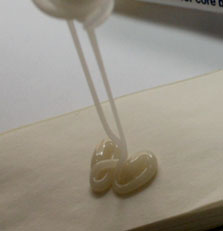
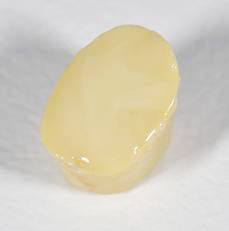 Picture 6. Cap-former filled with the composite material
Picture 6. Cap-former filled with the composite material
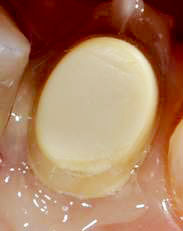
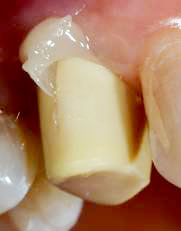 Picture 7. Forming teeth cores with the use of cap-former
Picture 7. Forming teeth cores with the use of cap-former
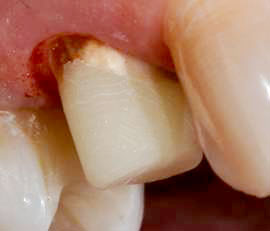
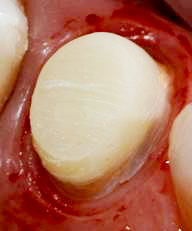 Picture 8. Teeth cores after necessary treatment
Picture 8. Teeth cores after necessary treatment
Discussion of study results
The following results have been achieved:
Table 1.
Results of tooth core reconstruction with the use of composite flowable dual-cure material «FlowCor Duo»
| |
Teeth cores reconstruct-ted, total |
Pins reworked |
Cleavages |
Cracks |
Pores |
Edge adoption of material |
| Composite flowable dual-cure material |
30 |
0 |
0 |
0 |
0 |
30 |
As may be seen from the table, out of 30 reconstructed teeth cores no one had cleavages, cracks or pores. The edge adoption of the material had 100% result. No single restoration had fissure between the material and tooth tissues.
No one fiberglass pin fixed by the composite material had to be re-worked through all the time of the study.
At the time when crowns were constantly fixed all 30 teeth cores had no visible changes and had wholesome constitution.
Until present time no one of the constant crowns lost fixation.
Conclusions
Dual polymerization provides possibility to fix with the use of 1 material the fiberglass pin and at the same time to form the tooth core for the crown. Working time of «FlowCor Duo» composite material is 2 minutes. If work has taken less time the polymerization may be achieved with the use of lamp.
The material has physical-mechanical properties close to those of dentin, which is important for the reconstruction of highly demolished teeth. Teeth cores have good adhesion to teeth tissues, strong enough, and they are easy to process.
The material is convenient to work with and is sufficiently cheaper than foreign analogues. But despite low price, the material is not inferior to foreign analogues in its qualities, or in many of them is even superior. All this, no doubt, should improve quality of medical service for patients from various social groups.
Bibliography
1. Волков В.В. Клинико-лабораторное обоснование ортопедического лечения разрушенных зубов плазмонапыленными штифтовыми конструкциями // Автореф. дисс. … канд. мед. наук., М.: 1999, 18с.
2. Дмитрович Д.А. Эффективность клинического применения отечественных и зарубежных стекловолоконных штифтов при реставрации зубов: Автореф. … к.м.н./ ГОУВПО «Моск. гос. медико-стомат. ун-т МЗ РФ», 2007.- 23С.
3. Ибрагимов Т.И., Добровольский П.В., Маркин В.А., Викулин А.В..Материалы, применяемые для восстановления культи зуба при последующем протезировании несъемными ортопедическими конструкциями// Стоматология для всех. – 2009. – № 3. – С. 44-47.
4. Christensen GJ., Christensen RP. Product use survey – 1995. CRA Newsletter 1995; 19: 3.
5. Cohen BI, Condos S, Deutsch AS, Musikant BL. Fracture strength of three different core materials in combination with three different endodontic posts. Int J Prosthodont 1994; 7:178.
6. Combe EC., Burke FJT. Dental Biomaterials. London: Kluwer Academic Publishers, 1999 pp. 339-344.
7. Combe EC., Burke FJT. Contemporary resin-based composite material for direct placement restorations: packables, flowable and others. Dent Update 2000; 27: 326-336.
8. Larson TD: Core restoration for crown preparation. Northwest Dent 2004;83:19-28.
9. Yaman SD, Karacaer O, Sahin M: Stress distribution of post-core applications in maxillary central incisors. J Biomater Appl 2004;18:163-177.
10. Wilson P.H.R., Fisher N.L., Bartlett D.W. Direct core materials. Dent Update. – 2003. – Vol. 30. – P. 362-368.





